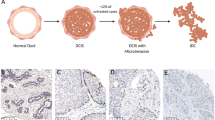Abstract
Ductal carcinoma in situ (DCIS) is a non-obligate precursor to invasive breast cancer. Although there is extensive information on the cellular and molecular changes in DCIS, there is limited ability to functionally test. The critical changes in premalignant progression. This review summarizes our experience with a recently developed method which provides. The opportunity to functionally test the molecular events occuring to functionally test the molecular events occurring in the initial changes in premaligant progression; i.e., the step from non-invasive to invasive behavior.


Similar content being viewed by others
Abbreviations
- MIND:
-
Mouse intraductal
- DCIS:
-
Ductal carcinoma in situ
- IBC:
-
Invasive breast cancer
- shRNAi:
-
short hairpin RNA inhibitor
References
Deome KB, Faulkin Jr LJ, Bern HA, Blair PB. Development of mammary tumors from hyperplastic alveolar nodules transplanted into gland-free mammary fat pads of female C3H mice. Cancer Res. 1959;19:515–20.
Behbod F, Kittrell FS, LaMarca H, Edwards D, Kerbawy S, Heestand JC, Young E, Mukhopadhyay P, Yeh HW, Allred DC, Hu M, Polyak K, Rosen JM, Medina D. An intraductal human-in-mouse transplantation model mimics the subtypes of ductal carcinoma in situ. Breast Canc Res. 2009;11:R66. Epub.
Valdez KE, Fan F, Smith W, Allred DC, Medina D, Behbod F. Human primary ductal carcinoma in situ (DCIS) subtype-specific pathology is preserved in a mouse intraductal (MIND) xenograft model. J Pathol. 2011;225:565–73.
Nguyen D-A, Beeman N, Lewis M, Schaack J, Neville MC, Ip MM, Asch BB. Intraductal injection in the mouse mammary gland. In: Ip MM, Asch BB, editors. Methods in Mammary Gland Biology and Neoplasia. New York: Kluwer; 2000. p. 259–70.
Du Z, Podsypanina K, Huang S, McGrath A, Toneff MJ, Bogoslovskaia E, Zhang X, Moraes RC, Fluck M, Allred DC, Lewis MT, Varmus HE, Li Y. Introduction of oncogenes into mammary glands in vivo with an avian retroviral vector initiates and promotes carcinogenesis in mouse models. Proc Natl Acad Sci U S A. 2006;103:17396–401.
Morrow M, Harris JR. Ductal Carcinoma in Situ and Microinvasive Carcinoma. In: Harris JR, Lippman ME, Morrow M, Osborne CK, editors. Diseases of the Breast. 3rd ed. New York: Lippincott, Williams and Wilkins; 2004. p. 521–37.
Tait LR, Pauley RJ, Santner SJ, Heppner GH, Heng HH, Rak JW, Miller FR. Dynamic stromal-epithelial interactions during progression of MCF10DCIS.com xenografts. Int J Cancer. 2007;120:2127–34.
Knudsen ES, Ertel A, Davicioni E, Kline J, Schwartz GF, Witkiewicz AK. Progression of ductal carcinoma in situ to invasive breast cancer is associated with gene expression programs of EMT and myoepithelia. Breast Cancer Research and Treatment. 2011 Dec. 2. [Epub ahead of print].
Lee S, Nagtegaal I, Wu Y, Tsimelzon A, Luo J, Medina D, Stewart S, Allred DC. Diagnostically specific genes regulating the progression of ductal carcinoma in situ to invasive breast cancer. (submitted)
Author information
Authors and Affiliations
Corresponding author
Rights and permissions
About this article
Cite this article
Medina, D., Edwards, D.G., Kittrell, F. et al. Intra-mammary Ductal Transplantation: A Tool to Study Premalignant Progression. J Mammary Gland Biol Neoplasia 17, 131–133 (2012). https://doi.org/10.1007/s10911-012-9259-z
Received:
Accepted:
Published:
Issue Date:
DOI: https://doi.org/10.1007/s10911-012-9259-z




